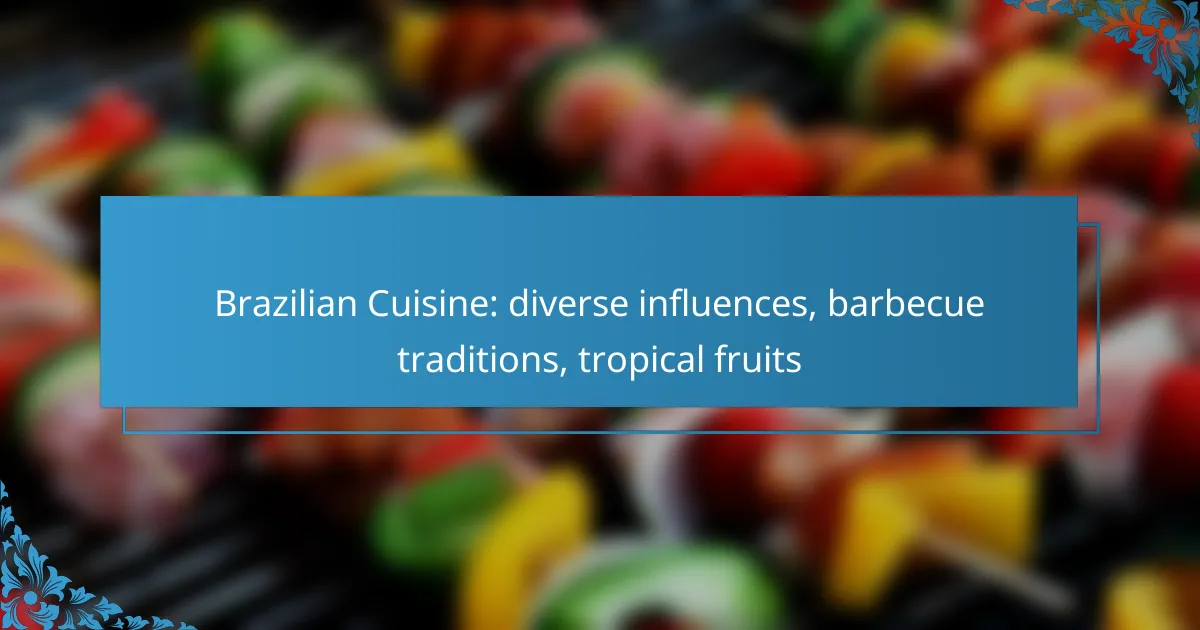Brazilian cuisine is a vibrant tapestry woven from indigenous, African, and European influences, celebrated for its bold flavors and regional specialties. Central to this culinary landscape is the barbecue tradition, which fosters communal dining and showcases a variety of grilled meats. Additionally, the use of tropical fruits like açaí and guava adds unique tastes and nutritional richness to the diverse array of dishes.

What are the popular dishes in Brazilian cuisine?
Brazilian cuisine is known for its rich diversity, influenced by indigenous, African, and European traditions. Popular dishes often feature bold flavors, hearty ingredients, and regional specialties that reflect the country’s cultural melting pot.
Feijoada
Feijoada is a traditional Brazilian stew made with black beans and a variety of salted pork or beef products. Typically served with rice, collard greens, and orange slices, it is considered the national dish of Brazil and is often enjoyed on Wednesdays and Saturdays.
When preparing feijoada, it’s essential to soak the beans overnight and simmer the dish for several hours to develop its deep flavors. The combination of meats can vary, but common choices include sausage, ribs, and smoked meats.
Moqueca
Moqueca is a flavorful fish stew that originates from the coastal regions of Brazil, particularly Bahia and Espírito Santo. It is made with fresh fish, tomatoes, onions, garlic, and coconut milk, giving it a creamy texture and tropical taste.
There are two main styles of moqueca: the Bahian version, which includes dendê oil (palm oil), and the Espírito Santo version, which is lighter and uses olive oil. Both styles are typically served with rice and can be garnished with fresh cilantro.
Brigadeiro
Brigadeiro is a beloved Brazilian sweet treat made from condensed milk, cocoa powder, butter, and chocolate sprinkles. These bite-sized chocolate truffles are a staple at birthday parties and celebrations across Brazil.
To make brigadeiro, cook the mixture over low heat until it thickens, then let it cool before rolling into small balls and coating with sprinkles. Variations can include different toppings or flavors, such as coconut or nuts.
Pão de Queijo
Pão de queijo are small, cheese-filled bread rolls that are popular as snacks or breakfast items in Brazil. Made primarily from tapioca flour and cheese, they are gluten-free and have a chewy texture.
These rolls are typically served warm and can be enjoyed plain or with various fillings. They are easy to prepare and can be frozen for later use, making them a convenient option for quick snacks.
Vatapá
Vatapá is a rich, creamy dish made from bread, shrimp, coconut milk, peanuts, and palm oil, often served with rice. This dish is deeply rooted in Afro-Brazilian cuisine, particularly in Bahia, and is known for its complex flavors and textures.
When preparing vatapá, blending the ingredients into a smooth paste is crucial for achieving the right consistency. It can be served as a main dish or as an accompaniment to other seafood dishes, enhancing the overall meal experience.

How does barbecue culture influence Brazilian cuisine?
Barbecue culture is a cornerstone of Brazilian cuisine, deeply rooted in social gatherings and regional traditions. It emphasizes grilling techniques, communal dining, and a variety of meats, showcasing the country’s diverse culinary influences.
Churrasco traditions
Churrasco refers to the Brazilian barbecue style, where large cuts of meat are cooked over open flames or charcoal. Traditionally, it is served with sides like farofa (toasted cassava flour) and vinaigrette. The experience is often communal, with friends and family gathering around the grill to enjoy the food together.
In many regions, churrasco is accompanied by music and lively conversation, making it not just a meal but a social event. The use of skewers, known as espetos, is common, allowing for various meats to be cooked simultaneously.
Popular cuts of meat
Brazilian barbecue features a range of popular cuts, including picanha (top sirloin), fraldinha (flank steak), and costela (beef ribs). Picanha is particularly prized for its flavor and tenderness, often seasoned simply with coarse salt before grilling.
Other favorites include chicken hearts and pork sausages, which are also commonly grilled. Each cut brings its unique taste and texture, contributing to the overall richness of the barbecue experience.
Regional barbecue styles
Brazilian barbecue varies significantly by region, reflecting local ingredients and cultural influences. In the south, for example, the gaúcho style emphasizes beef and is often accompanied by chimichurri sauce. In contrast, the northeast may feature more pork and seafood, showcasing tropical flavors.
Each region has its unique grilling techniques and preferred accompaniments, making Brazilian barbecue a diverse culinary adventure. Understanding these regional styles can enhance the appreciation of the country’s rich barbecue heritage.

What tropical fruits are commonly used in Brazilian dishes?
Brazilian cuisine features a variety of tropical fruits that enhance its flavor and nutritional profile. Commonly used fruits include açaí, cupuaçu, guava, and pineapple, each contributing unique tastes and textures to dishes.
Açaí
Açaí is a small, dark purple berry native to the Amazon rainforest, known for its rich antioxidant properties. It is often served as a smoothie bowl topped with granola, bananas, and honey, making it a popular breakfast or snack option.
When purchasing açaí products, look for those that are minimally processed and free from added sugars to maximize health benefits. Frozen açaí pulp is widely available in Brazil and can be found in specialty stores globally.
Cupuacu
Cupuacu is a creamy fruit related to cacao, with a unique flavor profile that blends chocolate and pineapple notes. It is commonly used in desserts, juices, and ice creams, providing a rich and exotic taste.
In Brazil, cupuaçu is often incorporated into sweets and beverages, making it a staple in regional cuisine. When using cupuaçu in recipes, consider its strong flavor, which pairs well with lighter ingredients like coconut or vanilla.
Guava
Guava is a versatile fruit that can be enjoyed fresh or used in jams, jellies, and desserts. Its sweet and slightly tart flavor makes it a favorite in both savory and sweet dishes across Brazil.
When selecting guavas, choose ones that are slightly soft to the touch, indicating ripeness. Guava paste is a popular ingredient in Brazilian snacks, often paired with cheese for a delightful contrast.
Pineapple
Pineapple is widely used in Brazilian cuisine, both fresh and grilled. Its sweet and tangy flavor enhances a variety of dishes, from salads to traditional barbecues (churrasco).
In Brazil, pineapple is often served as a refreshing dessert or blended into smoothies. For grilling, choose ripe pineapples, as their natural sugars caramelize beautifully over heat, adding depth to savory meals.

What are the regional influences on Brazilian cuisine?
Brazilian cuisine is shaped by a blend of indigenous, Portuguese, and African influences, creating a rich tapestry of flavors and ingredients. Each region of Brazil contributes unique elements, reflecting its history and cultural diversity.
Indigenous ingredients
Indigenous peoples of Brazil have long utilized a variety of native ingredients that are foundational to the country’s culinary identity. Staples such as cassava, corn, and a variety of tropical fruits like açaí and guava are integral to many traditional dishes.
These ingredients often feature in regional specialties, such as farofa (toasted cassava flour) and tacacá (a soup made with cassava and jambu). The use of local herbs and spices, such as cilantro and chili, further enhances the distinct flavors of indigenous cuisine.
Portuguese heritage
The arrival of Portuguese colonizers in the 16th century introduced new cooking techniques and ingredients that significantly influenced Brazilian cuisine. Ingredients like olive oil, garlic, and various meats became staples in Brazilian kitchens.
Traditional dishes such as feijoada, a black bean stew with pork, highlight this fusion. The Portuguese also brought sweets and desserts, leading to the creation of iconic treats like brigadeiro and pudim, which are now beloved across Brazil.
African culinary impact
African slaves brought to Brazil contributed significantly to the country’s culinary landscape, introducing flavors, cooking methods, and ingredients that remain prevalent today. Dishes like moqueca (a fish stew) and acarajé (a fried bean cake) showcase this influence.
Common ingredients such as palm oil, okra, and various spices reflect African cooking traditions. The celebration of African heritage is evident in festivals and communal meals, where these dishes are central to cultural identity and social gatherings.

How can I experience authentic Brazilian cuisine locally?
To experience authentic Brazilian cuisine locally, seek out Brazilian restaurants that offer traditional dishes and flavors. Look for establishments that focus on regional specialties, barbecue traditions, and the use of tropical fruits.
Local Brazilian restaurants
Finding local Brazilian restaurants is a great way to dive into the country’s diverse culinary landscape. Many cities have eateries that specialize in traditional dishes like feijoada, a hearty black bean stew, and various grilled meats known as churrasco.
When choosing a restaurant, consider those that source ingredients authentically and offer a menu reflective of Brazil’s regional diversity. For instance, some may focus on the coastal flavors of Bahia, while others might highlight the meat-heavy cuisine of the southern states.
Check online reviews and local food blogs for recommendations. Look for places that offer a vibrant atmosphere, as dining in Brazil is often a communal experience, enhanced by music and lively conversation.
